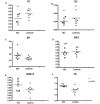Altered dopaminergic profile in the putamen and substantia nigra in restless leg syndrome
- PMID: 19467991
- PMCID: PMC2732265
- DOI: 10.1093/brain/awp125
Altered dopaminergic profile in the putamen and substantia nigra in restless leg syndrome
Abstract
Restless leg syndrome (RLS) is a sensorimotor disorder. Clinical studies have implicated the dopaminergic system in RLS, while others have suggested that it is associated with insufficient levels of brain iron. To date, alterations in brain iron status have been demonstrated but, despite suggestions from the clinical literature, there have been no consistent findings documenting a dopaminergic abnormality in RLS brain tissue. In this study, the substantia nigra and putamen were obtained at autopsy from individuals with primary RLS and a neurologically normal control group. A quantitative profile of the dopaminergic system was obtained. Additional assays were performed on a catecholaminergic cell line and animal models of iron deficiency. RLS tissue, compared with controls, showed a significant decrease in D2R in the putamen that correlated with severity of the RLS. RLS also showed significant increases in tyrosine hydroxylase (TH) in the substantia nigra, compared with the controls, but not in the putamen. Both TH and phosphorylated (active) TH were significantly increased in both the substantia nigra and putamen. There were no significant differences in either the putamen or nigra for dopamine receptor 1, dopamine transporters or for VMAT. Significant increases in TH and phosphorylated TH were also seen in both the animal and cell models of iron insufficiency similar to that from the RLS autopsy data. For the first time, a clear indication of dopamine pathology in RLS is revealed in this autopsy study. The results suggest cellular regulation of dopamine production that closely matches the data from cellular and animal iron insufficiency models. The results are consistent with the hypothesis that a primary iron insufficiency produces a dopaminergic abnormality characterized as an overly activated dopaminergic system as part of the RLS pathology.
Figures






References
-
- Allen R. Dopamine and iron in the pathophysiology of restless legs syndrome (RLS) Sleep Med. 2004;5:385–91. - PubMed
-
- Allen RP, Barker PB, Wehrl F, Song HK, Earley CJ. MRI measurement of brain iron in patients with restless legs syndrome. Neurology. 2001;56:263–5. - PubMed
-
- Allen RP, Earley CJ. Defining the phenotype of the restless legs syndrome (RLS) using age-of-symptom-onset. Sleep Med. 2000;1:11–9. - PubMed
-
- Allen RP, Picchietti D, Hening WA, Trenkwalder C, Walters AS, Montplaisir J. Restless legs syndrome: diagnostic criteria, special considerations, and epidemiology. A report from the restless legs syndrome diagnosis and epidemiology workshop at the National Institutes of Health. Sleep Med. 2003;4:101–19. - PubMed
Publication types
MeSH terms
Substances
Grants and funding
LinkOut - more resources
Full Text Sources
Other Literature Sources
Medical

